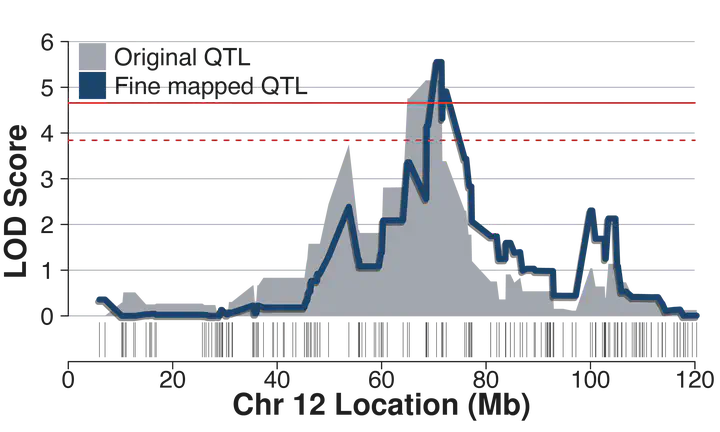Fine mapping a quantitative trait locus for the anxiolytic-like response to acute ethanol in BXD recombinant inbred strains

Abstract
Initial responses to acute ethanol are heritable predictors of an individual’s proclivity for ethanol consumption and long-term risk for alcohol dependence, and provide a convenient model for investigating genetic correlates of susceptibility to alcoholism. Anxiety attenuation is an acute ethanol response of particular importance because anxiolysis is considered a primary motivator for habitual drinkers and substantial comorbidity exists between anxiety disorders and alcohol dependence. Our lab has used the BXD panel of recombinant inbred mice and the light-dark box model of anxiety to dissect genetic variation of the anxiolytic-like response to acute ethanol. All strains received IP injections of ethanol (1.8g/kg) or saline 10 minutes prior to entering the light-dark box. Global gene expression levels in prefrontal cortex and nucleus accumbens were concurrently measured across BXD lines from both treatment groups using Affymetrix microarrays. We have recently identified a quantitative trait locus (QTL) significantly associated (LOD 4.7) with acute ethanol-induced anxiolysis (Etanq1) on chromosome 12. The initial support interval for Etanq1 covered 26.2 megabases (Mb), including 137 known or predicted genes. Here, we present results of our initial effort to fine-map Etanq1 by studying novel BXD lines from an advanced intercross that carry informative recombinations within the Etanq1 support interval. The additional strains increased the LOD score of Etanq1 to 5.68 and reduced the support interval to approximately 10 Mb. The updated interval now spans 65.9-74.9 Mb on Chr12 and contains 80 genes. We used the BXD microarray data to facilitate the process of screening for candidate genes by conducting expression QTL (eQTL) analysis. Genes showing cis eQTLs within the Etanq1 region are considered strong candidates, since the local sequence polymorphisms driving the allele-specific differences in expression may be modulating the degree of anxiolysis induced by acute ethanol. We have identified 14 cis eQTLs with LOD scores ≥ 3 in the support interval, representing 7 unique genes. Bioinformatic analysis suggests these cis eQTLs are not due to polymorphisms affecting microarray performance and show that several genes have strong correlations with our behavioral phenotype. These results may identify novel mechanisms underlying ethanol anxiolysis and provide new candidates for future interventions in alcoholism. Supported by NIAAA INIA grants AA016667 and AA016662.